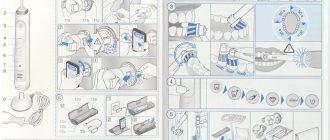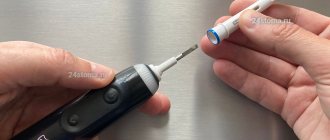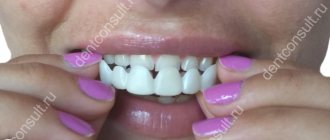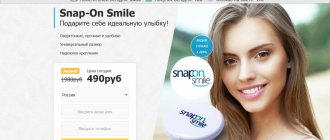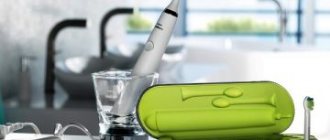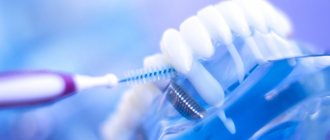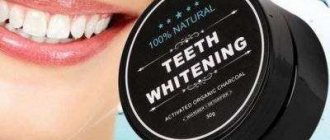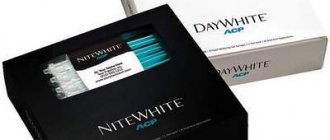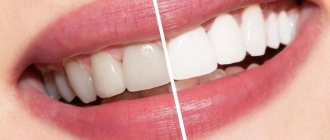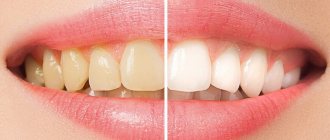Philips Sonicare electric brushes are considered one of the most technologically advanced. They allow you to quickly clean your mouth of food debris and get rid of plaque. Such devices are not cheap, so you need to learn how to use them.
In this article
- Philips Sonicare electric brushes: advantages and disadvantages
- How to choose a Philips electric toothbrush
- How to brush your teeth with a Philips brush
- How to care for your Philips Sonicare electric toothbrush
Let's learn how to properly brush your teeth with Philips brushes and how to care for them.
Manufacturers of electric toothbrushes regularly update their range of products and release new models every year. They are becoming more and more functional, convenient and practical. The popularity of such devices is also growing. Philips Sonicare electric brushes are in great demand.
They cost a little more than many other models, but, according to dentists, it is better not to skimp on hygiene products. Treating teeth or cleaning them from plaque in a clinic is much more expensive. Let's look at the advantages of Philips Sonicare brand brushes. After that, we will tell you how to use them so as not to harm your teeth and extend the life of the device.
series Rechargeable sonic toothbrush…
Healthywhite
- Image
- Text
- Content
HealthyWhite
700 series
Rechargeable
sonic toothbrush
- English Important Danger
- Warning
- Caution
- Electromagnetic fields (EMF)
- Changing the color code ring
- Brushing instructions Clean and White mode brushing instructions
- Clean mode
- Easy-start Deactivating or activating the Easy-start feature
- Toothbrush handle
- Brush head
- Removing the rechargeable battery
- Guarantee restrictions Fare
- Vigtigt Elektromagnetiske felter (EMF)
- Udskiftning af farvekode-ring
- Børstevejledning Børstevejledning til Clean and White-indstilling
- Clean-indstilling
- Easy-start Deaktivering eller aktivering af Easy-start
- Tandbørstens håndtag
- Borstehoved
- Udtagning af det genopladelige batteri
- Gældende forbehold i reklamationsretten Peligro
- Importante Campos electromagneticos (CEM)
- Cómo cambiar el aro de código de color
- Instrucciones de cepillado Instrucciones de cepillado en el modo Clean & White
- Modo Clean (Limpieza)
- Easy-start Cómo desactivar o activar la función Easy-start
- Mango del cepillo
- Cabezal del cepillo
- Cómo extraer la batería recargable
- Restricciones de la garantía Vaara
- Tärkeää Sähkömagneettiset kentät (EMF)
- Värirenkaan vaihtaminen
- Harjausohjeet Puhdas ja valkoinen -tilassa harjaaminen
- Puhdistustila
- Easy-start Easy-start-toiminnon ottaminen käyttöön tai poistaminen käytöstä
- Hammasharjan runko
- Harjaspää
- Akun poistaminen
- Takuun rajoitukset Pericolo
- Importante Campi elettromagnetici (EMF)
- Sostituzione della ghiera colorata
- Istruzioni d'uso Istruzioni d'uso in modalità pulizia e sbiancamento
- Modalità pulizia
- Easy-start Disattivazione/attivazione della funzione Easy-start
- Manico dello spazzolino
- Testina
- Rimozione della batteria ricaricabile
- Limitazioni della garanzia Fare
- Viktig Elektromagnetiske felt (EMF)
- Bytte ring med fargecode
- Børsteinstruksjoner Pusseinstruksjoner for ren-og-hvit-modus
- Rengjøringsmodus
- Easy-start Deaktivere eller aktivere Easy-start-funksjonen
- Tannbørstehåndtak
- Borstehode
- Fjerne det oppladbare batteriet
- Begrensninger i garantien Perigo
- Importante Campos Electromagnéticos - EMF (Electro Magnetic Fields)
- Mudar o anel colorido
- Instruções de escovagem Instruções para o modo de escovagem Clean and White
- Modo Clean
- Easy-start Activar ou desactivar a função Easy-start
- Pega da escova de dentes
- Cabeça da escova
- Retirar a bateria recarregável
- Restrições à garantia Dangerous
- Caution Electromagnetic fields (EMF)
- Color coded ring change
- Cleaning tips Clean and White cleaning tips
- Cleaning mode
- Easy-start function Enable or disable the Easy-start function
- Toothbrush handle
- Brush attachment
- Removing the Battery
- Fara Warranty Limitation
- Viktigt Elektromagnetiska fält (EMF)
- Byte av färgkodad ring
- Borstningsanvisningar Borstningsinstruktioner för rengörings- och vitläget (Clean och White)
- Rengöringsläge (Clean)
- Easy-start Avaktivera eller aktivera Easy-start-funktionen
- Tandborsthandtag
- Borsthuvud
- Ta ut det laddningsbara batteriet
- Garantibegränsningar
Philips Sonicare electric brushes: advantages and disadvantages
Philips products are recognized as reliable and high quality. In this case, we are talking not only about toothbrushes, but also about other equipment. Oral cleaning devices manufactured under the Philips Sonicare brand are no exception. Experts name the following advantages:
- allow you to quickly cleanse the oral cavity of germs and food debris;
- help eliminate plaque and prevent its formation;
- suitable for almost everyone, as they have no contraindications;
- equipped with many functions, sensors and indicators;
- Compatible with various attachments.
The only disadvantage of Philips Sonicare electric toothbrushes is their high price compared to other models. The attachments are also expensive. However, there is an opportunity to save money: the whole family can use one device, just each member must have their own nozzle. In addition, it offers a large selection of toothbrushes, among which you can find an affordable model.
How to care for your Philips Sonicare electric toothbrush
A regular brush can last 2-3 months even with very careful use. Attachments for electrical devices have a shelf life of 3-4 months with daily use twice a day. However, if you do not take care of the device, it may fail sooner.
Tips for proper use of electric brushes:
- Rinse the bristles thoroughly after the procedure. Between them there may be food debris that becomes a source of bacteria.
- Change the nozzle in a timely manner. It is contraindicated to use a brush whose bristles fall out and separate. There is a risk of injury to gums and teeth.
- Keep the device clean. Put it in a cabinet to keep it away from dust. When transporting the device, place it in the case.
An electric brush allows you to maintain oral hygiene better than a manual one. However, the choice of this device must be taken responsibly. It is important that it suits you in all respects. We have the following Philips Sonicare brushes in our online store:
- Philips Sonicare 2 series Plaque Control HX6212/87;
- Philips Sonicare CleanCare+ HX3292/44;
- Philips Philips Sonicare For Kids HX6322/04(02);
- Philips Sonicare DiamondClean HX9372/04;
- Philips Sonicare ProtectiveClean 4500 HX6829/14;
- Philips Sonicare Gum Health 2 series HX6232/20.
They are produced in different color options. Any of these models meets high quality requirements. Visit your dentist's office before purchasing a device.
CleanCare+ HX 3212/03
Like previous models, this brush has one operating mode and one cleaning head. With regular use of the product, the manufacturer guarantees not only the removal of plaque, but also the improvement of the condition of the gum tissue, as well as the elimination of pigmented areas of the enamel.
A two-mode timer allows you to most effectively control the time required to completely clean your teeth.
The disadvantages of the product include a weak battery - the brush can work for no more than 10 days without recharging. This explains the rather low cost of the brush - it can be purchased from an official distributor for 3,000 rubles.
DiamondClean HX 9352/04
In addition to the usual removal of plaque, this ultrasonic brush is positioned as a means of enamel whitening, which is achieved due to the presence of a set of operating modes:
- daily cleaning;
- delicate impact;
- gum care;
- polishing and bleaching mode;
- bleaching.
The key feature of the DiamondClean HX 9352 / 04 model is the diamond-shaped tip of all the bristles of the product, thanks to which their penetration into the interdental crevices and the space between the elements of the orthodontic structure is achieved.
Within a minute, the bristles of the product make up to 31,000 sweeping movements, which forms a directed flow of liquid consisting of saliva and toothpaste, which effectively removes plaque located between the teeth and in the gum pockets.
Thanks to the lithium-ion battery installed in the product, the product can operate without additional charging for up to 3 weeks with twice daily use.
The brush comes with two standard replacement heads, allowing the device to be used by two family members. The cost of the model from the official distributor is 18 thousand rubles.
How to brush your teeth with a Philips brush
When brushing your teeth with an electric brush, do not use a back-and-forth motion like you would with a regular toothbrush. This can damage the enamel or the device. The procedure is carried out as follows:
- Preparation. Wet the bristles with water and squeeze toothpaste onto them. The vibrations of the hairs promote the formation of foam, so you don’t need a lot of it: a pea-sized portion is enough. You can use any paste, but dentists do not recommend buying formulations with a high content of abrasive particles that can damage the enamel. Brushing your teeth with an electric brush helps remove plaque without using special toothpastes.
- Select the correct brush position. When treating the chewing surface of your teeth, you need to hold the device horizontally. When moving to the incisors, give it a vertical position. The bristles on the brushes are arranged in such a way as to reach hard-to-reach places, so no effort is required.
- Cleaning the outside of the jaw. Bring the operating device to your teeth at a 45° angle. Hold the head on each of them for about 2-3 seconds without pressing on them. Philips brushes have timers that warn you about moving to another area of the jaw with vibration or a sound signal. After cleaning the outer surface, you can move on to the inner surface.
- Completion of the procedure. The recommended duration of brushing your teeth is 2 minutes. Philips Sonicare devices signal the end of the procedure or turn off. Some models can be synced with a smartphone using Bluetooth to keep track of the time in the app. After cleaning, rinse your mouth with clean water or balm, rinse the nozzle and blot it with a dry towel to dry it slightly.
Brushing your teeth with a Philips brush is so easy that even a child can cope with this task. In addition, the company produces special devices intended for children from 3 years old.
Pros, cons and final verdict
pros
- Excellent value for money in the Philips range.
- A really comfortable head that reaches the far teeth.
- The brush works quite quietly.
- Charge indicator: it’s convenient that you can see when it’s time to charge the brush.
- Bright, attractive design.
- It fits comfortably in the hand and does not slip out.
Minuses
- No pressure sensor.
- Only one cleaning mode - although this is quite enough.
- Battery life is up to 16 days. This is the smallest figure in the Philips lineup, but for me it is not critical. There is enough charge for a full vacation.
Verdict
A good brush that is pleasant to hold in your hand and which pleases with its bright design. There are no complaints about the work. I use it with low-abrasive toothpaste (RDA up to 50).
Contraindications
Almost all contraindications to using an electric brush are relative or temporary. The use of the device should be discontinued in the following clinical situations :
- after surgery in the dentofacial area;
- stomatitis;
- tooth mobility grade 3;
- after oncological surgery;
- hypertrophic gingivitis.
Note! Only after eliminating such pathologies or abnormalities can you begin to use an electric device for brushing your teeth.
If you experience unpleasant sensations while using the brush, it is better to abandon them completely.
X 6631/01
The sonic brush X 6631/01 is equipped with one mode of operation and three options for intensity of exposure, so the user can choose the most comfortable one, based on the condition of the enamel and gums.
This feature provides a gentle effect on the gum tissue, which is manifested in a reduction in the level of bleeding, swelling and redness. The bristles of the removable nozzle have a shorter length in the middle part, which contributes to the most thorough removal of plaque from the tooth surface.
The model's timer has two operating modes and can emit a signal either after two minutes of operation of the device or every 30 seconds, notifying you of the need to change the zone of the dentition.
The brush comes with one cleaning head and a charger. The cost of such a set is 7,000 rubles.
Equipment
At first glance at the weighty packaging, it becomes clear that DiamondClean Smart is a serious device, before using which you need to carefully study the instructions and understand each item in the box. The kit includes: a handle (brush base), four different attachments with a case, a brush case, instructions, a charging cup and the charging station itself.
The shockproof carrying case deserves special attention. The hidden compartment contains a USB charger, so the brush can be recharged while traveling from any laptop or a regular 5 V and 1 A plug for a smartphone. The case holds the brush handle, as well as two attachments. This case is a good option for business trips and city travel, but it’s still not very convenient to take it on a hike: it looks like a case for giant glasses and takes up quite a lot of space in the bag.
Description of nozzles
Philips has been producing replacement heads for a long time. During the transformation, they slightly changed their shape, color and even name. In parentheses we provide the letter code and an alternative name that you may see somewhere. Philips brushes have 11 types of attachments.
- ProResults
(C1 ProResults). - Sensitive
(S). - InterCare
(i). - Optimal Plaque Defense
(C2 Optimal Plaque Control). - Optimal Gum Care
(G2). - DiamondClean
(W2 Optimal White). - Premium Plaque Defense
(C3 Premium Plaque Control). - Premium GumCare
(G3). - Premium White
(W3). - TongueCare
(T1 TongueCare+). - For Kids
.
All Philips brush heads have the usual oblong shape, like manual brushes, and are designed to cover 2 teeth and 3 interdental spaces.
Conventionally, they can be divided into regular, reduced and enlarged. The first generation attachments, such as ProResults, Sensitive and InterCare, have a regular size. Smaller heads make it easier to clean hard-to-reach areas, such as the back teeth and the space behind them. On the contrary, larger nozzles make it more difficult to clean such places.
Special attachments (for example, whitening) will work more efficiently in the appropriate mode. This is provided by BrushSync technology (we will tell you more about it later). The brush itself will turn on the desired mode, understanding which attachment you are using. You can also use any mode at your discretion.
By the way, BrushSync will remind you when it’s time to replace the nozzle, but if this function is not present, the blue indicator bristles will tell you about wear - they will turn white. These bristles are found on each attachment (except For Kids).
What do the numbers after the name say?
The digital and alphabetic coding that follows the name of the device - for example, HX3212/03 or HX6232/20, etc., is information for employees and sellers at retail outlets. The encoding combines a lot of data - model modification, handle, batch number, etc. Such marking simplifies the accounting of goods - after all, a digital code is much easier to track than a name, which may be incorrectly translated into other languages. It also simplifies checking for the sale of non-original (counterfeit) goods.
Ninth step
Check if the toothbrush is dry, and if the answer to this question is yes, place it on a special stand. If the brush's charge is low, it is recommended to place it in the charging station in a timely manner so that the device is fully ready for use by the next time you brush your teeth. If the brush is set to recharge, we recommend that you monitor the charging process by turning off the gadget in a timely manner, because excessive charging installation time will not benefit the brush.
How to choose a Philips electric toothbrush
How to choose an electric brush and learn how to properly brush your teeth with it? Let's answer these common buyer questions. To choose a good device, evaluate the following parameters:
- Head shape and size. The brush should cover no more than two teeth. Otherwise, it will be ineffective as it will not be able to clean the interdental spaces. The diameter of the head can be from 1.3 to 2 cm. Small brushes are suitable for children, large ones for adults.
- The stiffness of the bristles. They can be soft, medium hard or hard. The first ones are better for children and those with sensitive gums, the second ones for all other people with healthy teeth, and the third ones for medical reasons.
- Number of nozzles. The Philips Sonicare electric toothbrush usually comes with one or two attachments, in rare cases - three. They can also be purchased separately. Each is designed for a specific cleaning mode: standard, delicate, whitening, massage, etc.
- Functionality. All Philips toothbrushes are equipped with timers, which make brushing your teeth correctly very easy. Every 30 seconds the device reminds you to move on to cleaning another part of the jaw. After 2 minutes, the device will indicate the end of the procedure or turn off on its own.
- Pressure sensor. An electric brush with a pressure indicator is even easier to use. If you press too hard on your teeth, the device stops working. This reduces the risk of injury to enamel and gums.
- Type of food. If you will only brush your teeth at home, choose models with batteries. People who travel frequently can opt for devices powered by AA batteries.
- Convenience. Using an electric toothbrush is much more pleasant if it does not slip out of your hands, so choose devices with a comfortable handle, low specific gravity, rubberized handle, etc.
If the toothbrush is intended for a child, choose a model with an interesting design. This way you can quickly accustom your baby to oral hygiene.
Now we’ll tell you how to properly brush your teeth with a Philips Sonicare electric brush.
HealthyWhite HX 6711/02
This model has two operating modes:
- deep cleaning is carried out for two minutes at a speed of about 31 thousand vibrations of bristles per minute;
- Cleaning and bleaching involves operating the product normally for two minutes, followed by a 30-second bleaching cycle.
The device timer has one programming option - turning on a sound signal after two minutes of the device being turned on.
In addition to the brush itself, the product package includes one replaceable brush head, multi-colored rings that allow the device to be used by multiple users, and a charger.
The cost of the product ranges from 4 to 5 thousand rubles.
Terms of use
The first thing the owner of this type of toothbrush should know is that they don’t brush their teeth like they usually do.
- Under no circumstances should it make translational movements along the surface of the teeth.
- When brushing, you need to stop the nozzle on the surface of each tooth for 3-5 seconds so that it only gently touches its surface. After this, you can begin brushing the next tooth.
- You can choose the order of brushing your teeth yourself. At the same time, it is necessary to remember one important piece of advice that manufacturers give to their customers - do not put pressure on the tooth and hold the brush on it for too long.
